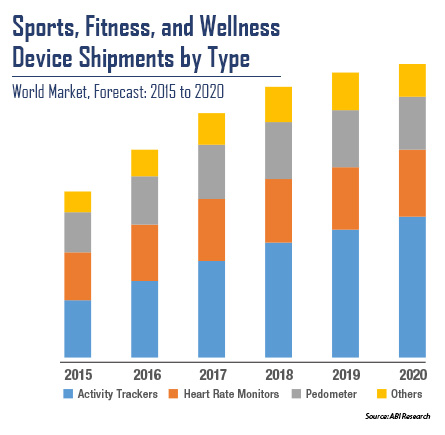It’s funny, there is so much hype around wearables, yet few I speak to are fully convinced about converged devices- there is a real emperor’s new clothes feel about this market that is leaving many reluctant to truly back it unless the emperor (in this case Apple) says it’s okay-to paraphrase a semi-famous neighbour, “the rich buy dearest cause they need to be sure”. In an unusual reversal of trends, todays converged wearables are largely coming ahead of dedicated devices targeting the real opportunity here - health, quantified self and ambient intelligence. In a lot of cases, these markets will initially be best served by sensor heavy devices that can be worn or placed in the environment, but do not necessarily require a detailed user interface like a wearable watch.
 The opposite is true of BLE beacons. In "BLE Tags and the Location of Things" ABI Research is forecasting that these things are going to go everywhere and become as common a tool in our lives as keys – we just need to convince everybody else!! With the launch of Estimotes BLE beacon stickers, and thus creating the term nearables, Steve Cheney gave a lovely analogy of what a BLE beacon can be, “Beacons are a little like URLs for the physical world”, which reminds me of how apps were described when they were first launched “a bit like your internet favourites list, when people couldn’t remember internet URLs” and that seems to have worked out well.
The opposite is true of BLE beacons. In "BLE Tags and the Location of Things" ABI Research is forecasting that these things are going to go everywhere and become as common a tool in our lives as keys – we just need to convince everybody else!! With the launch of Estimotes BLE beacon stickers, and thus creating the term nearables, Steve Cheney gave a lovely analogy of what a BLE beacon can be, “Beacons are a little like URLs for the physical world”, which reminds me of how apps were described when they were first launched “a bit like your internet favourites list, when people couldn’t remember internet URLs” and that seems to have worked out well.
Long term, we can imagine an IoE world where everything has connectivity integrated as standard, but until that becomes a reality, nearables are clearly the way forward in terms of combining apps with objects in the physical world.
As far as nearables/ BLE Beacons go, companies are giving a lot of different use cases such as automatic door opening/alerts, turning off phones at cinemas, starting coffee machines, etc, the major difficulty here is application fatigue. Certainly there will be some clear silos around health/fitness, connected home and retail, corporate, which is where a lot of the focus is today. We can see companies looking to control these silos with one all-inclusive application. With iOS 8, Apple is helping to solve a lot of these problems, alerting people when an app/beacon is in range and also creating centralized hubs to manage these different silos. Google with its acquisition of NEST, is no doubt taking a similar approach.
Which brings me back to wearables. Nearables could be the link in the chain that converged wearables is missing at the moment. Yes the ability to connect to the phone is kind of useful, but a nearable is far more useful as it bypasses the body and connects the phone to its environment. As a result it may steal some wearable thunder over the next 2 years. However, the ability to be a link between the phone and the connected world could be much more valuable for the type of converged device that Samsung, Google (Glass) and Apple (if speculation is to be believed) are launching. If BLE beacons become as prevalent as we envision, interactions will need to become largely automated, while regular alerts and updates and binary actions can be handled via a wearable, allowing the smartphone to become what it ultimately will become, our personal home computer.
I also pulled this graph on projected growth of sports oriented wearables from their recent newsletter, The Insider.

